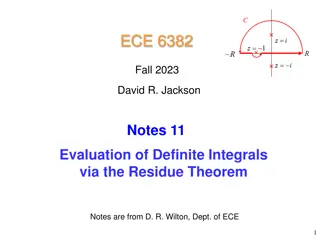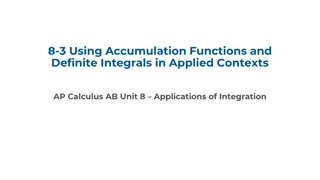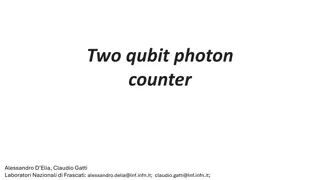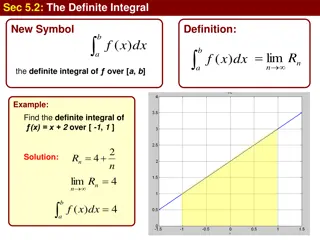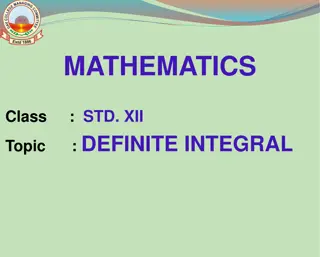Advanced Quantum Chemistry: Solving Secular Determinants and Integrals
Lecture 3 delves into secular determinants, overlap, resonance, and Coulomb integrals, introducing the Hückel approximation method for molecular orbital calculations in inorganic and solid-state chemistry. The lecture explains the approximations made, simplifying the calculation of integrals and enabling easier solution of secular determinants in complex systems like conjugated hydrocarbons.
Download Presentation

Please find below an Image/Link to download the presentation.
The content on the website is provided AS IS for your information and personal use only. It may not be sold, licensed, or shared on other websites without obtaining consent from the author.If you encounter any issues during the download, it is possible that the publisher has removed the file from their server.
You are allowed to download the files provided on this website for personal or commercial use, subject to the condition that they are used lawfully. All files are the property of their respective owners.
The content on the website is provided AS IS for your information and personal use only. It may not be sold, licensed, or shared on other websites without obtaining consent from the author.
E N D
Presentation Transcript
CHE-30042 Inorganic, Physical & Solid State Chemistry Advanced Quantum Chemistry: lecture 3 Rob Jackson LJ1.16, 01782 733042 r.a.jackson@keele.ac.uk www.facebook.com/robjteaching @robajackson
Lecture 3 contents 1. Secular determinants revised 2. Overlap, resonance and Coulomb integrals 3. Introducing the H ckel approximation 4. Applying the H ckel conjugated hydrocarbons 5. Delocalisation energy 6. Aromatic systems approximation to 2 che-30042 Advanced QC lecture 3
Secular determinants revised From lecture 2 we wrote the secular determinant for a diatomic molecule as: H11 - S11 H12 - S12 = 0 H21 - S21 H22 - S22 This can be expanded to give a quadratic equation that can be solved to give two values of , one for each orbital, provided we know H and S. 3 che-30042 Advanced QC lecture 3
Overlap, resonance and Coulomb integrals A reminder of the integral expressions Slk = l k d (Overlap integral) Their value depends on the degree of overlap of the orbitals. (Remember they are = 1 if l = k) Hll = l H l d (Coulomb integral) The energy an electron would have in a particular orbital. Hlk = l H k d (Resonance integral) = 0 if there is no overlap. 4 che-30042 Advanced QC lecture 3
The Hckel approximation The main problem with molecular orbital calculations is associated with calculating the integrals introduced in the last lecture, and revised on slide 4.. Later we will see how to try to calculate them in full. The H ckel approach neatly sidesteps the problem by making assumptions about the values of the integrals, which are listed on the next slide: 5 che-30042 Advanced QC lecture 3
Approximating the integrals In the H ckel method it is assumed that: All overlap integrals, Slk = 0 unless l = k, when they = 1 All Coulomb integrals, H11, H22 etc. are set to All resonance integrals between neighbouring atoms (e.g. H12, H23) are given the value (normally negative). All resonance integrals between non-neighbouring atoms (e.g. H13, H14) are set to 0 Enables secular determinants to be solved more easily! 6 che-30042 Advanced QC lecture 3
Background: molecular orbitals for conjugated hydrocarbons Conjugated hydrocarbons are characterised by having a mix of and bonding; the bonds are responsible for holding the molecule together, while the bonding is delocalised, with the electrons free to move around the molecule. The H ckel approach (H ckel, 1930) provides a more accurate description of bonding. H ckel, E. (1930) Zeitschrift f r Physik60 (7 8): 423 456. doi:10.1007/BF01341254. 7 che-30042 Advanced QC lecture 3
Applying the Hckel approximation to simple hydrocarbons containing electrons Although the H ckel approximation is most useful for conjugated and aromatic hydrocarbons, we will apply it to a simple example first to illustrate how it works for localised orbitals. We will apply it to ethene, remembering that we are only looking at the molecular orbitals, which result from overlap of the pz orbitals on each C atom. 8 che-30042 Advanced QC lecture 3
Wavefunctions and energies of H ckel orbitals of ethene (i) We start with a wavefunction in terms of 1 atomic orbital on each C atom: = c1 1 +c2 2 Following the procedure explained in lecture 2, we obtain the energy by solving the secular determinant: But the determinant is easier to solve making the H ckel approximation. -E = 0 -E H11 - ES11 H21 - ES21 H12 - ES12 = 0 H22 - ES22 9 che-30042 Advanced QC lecture 3
Wavefunctions and energies of Hckel orbitals of ethene (ii) Expanding the determinant gives a quadratic equation: ( - E)2 = 2 The solutions to this (obtained by expanding the equation and applying the quadratic formula) are: E = These are the energies of the orbitals. What about the wavefunctions? The secular equations are (slide 15 lecture 2): c1 ( - E) + c2 = 0, c1 + c2 ( - E) = 0 10 che-30042 Advanced QC lecture 3
Wavefunctions and energies of Hckel orbitals of ethene (iii) If we substitute the two possible values for E in either of these equations, we find the following: When E = + , c1 = c2, so b = c1 1 +c1 2 When E = - , c1 = -c2, so a = c1 1 -c2 2 Here b and a denote bonding and antibonding orbitals. They will be sketched in the lecture, or you can find a better diagram in Hayward p 172. However, the H ckel method was really devised for larger molecules, particularly with alternating double and single bonds. 11 che-30042 Advanced QC lecture 3
Application of the Hckel approach to butadiene First we note that the framework of the molecule is held together by bonds formed by overlap of sp2 hybrid orbitals on the C atoms, and that further bonds are formed by overlap of C sp2 orbitals and H 1s orbitals. The 2pz orbitals on the C atoms are oriented perpendicular to the plane of the molecule, and overlap to form orbitals. The H ckel approach is used for these orbitals. 12 che-30042 Advanced QC lecture 3
The Hckel approach to -bonding in butadiene (i) We form a molecular orbital from the 2pz orbitals on the 4 C atoms: = c1 1 +c2 2 + c3 3 +c4 4 This leads to 4 secular equations: c1(H11 - ES11) + c2(H12 - ES12) + c3(H13 - ES13) + c4(H14 - ES14) = 0 c1(H21 - ES21) + c2(H22 - ES22) + c3(H23 - ES23) + c4(H24 - ES24) = 0 c1(H31 - ES31) + c2(H32 - ES32) + c3(H33 - ES33) + c4(H34 - ES34) = 0 c1(H41 - ES41) + c2(H42 - ES42) + c3(H43 - ES43) + c4(H44 - ES44) = 0 Now form the secular determinant! che-30042 Advanced QC lecture 3 13
The Hckel approach to -bonding in butadiene (ii) This leads to a secular determinant: H11 - ES11 H12 - ES12 H13 - ES13 H14 - ES14 = 0 H21 - ES21 H22 - ES22 H23 - ES23 H24 - ES24 H31 - ES31 H32 - ES32 H33 - ES33 H34 - ES34 H41 - ES41 H42 - ES42 H43 - ES43 H44 - ES44 Simplify the determinant, making the approximations on slide 6. Pay particular attention to resonance integrals. Hayward (p 168) then shows how the determinant is solved, and energies and determined. weighting coefficients 14 che-30042 Advanced QC lecture 3
Delocalisation energy in butadiene The total electron energy in butadiene (Hayward p169 fig. 8.26) is: 2 x ( + 1.62 ) + 2 x ( + 0.62 ) = 4 + 4.48 Compare this with the electron energy of 2 ethene molecules (slide 8): 2 x 2 ( + ) = 4 + 4 Because is negative (slide 6), this means that the electron energy in butadiene is lower than the 2 localised bonds in ethene by 0.48 . This is called the delocalisation energy. 15 che-30042 Advanced QC lecture 3
Hckel theory applied to aromatic molecules The stability of aromatic molecules can be related to the delocalisation of the electrons. Taking benzene as an example, hybridisation of the C orbitals gives sp2 orbitals which overlap to give bonding within the plane of the molecule (Hayward figure 8.30). The C 2pz orbitals are at 90 and form a separate molecular orbital: http://en.wikipedia.org/wiki/Aromaticity 16 che-30042 Advanced QC lecture 3
Delocalisation in aromatic molecules Following the procedure on slide 9, we write the H ckel molecular orbitals as: = c1 1 +c2 2 + c3 3 +c4 4 +c5 5 +c6 6 The secular determinant is written, using the notation on slide 4: -E 0 0 0 = 0 -E 0 0 0 0 -E 0 0 0 0 -E 0 0 0 0 -E 0 0 0 -E Note the difference with butadiene in that there are now 2 extra terms to account for H16 and H61 because in the ring they are connected. 17 che-30042 Advanced QC lecture 3
Delocalisation energy in benzene (i) Expansion of this secular determinant gives 6 roots which give the energies of the 6 H ckel orbitals in benzene. They are shown on p 174, fig. 8.32 of Hayward The energies are: 2 , , We can compare the energy of the delocalised orbitals with localised ones, as we did for butadiene: 18 che-30042 Advanced QC lecture 3
Delocalisation energy in benzene (ii) In benzene, the 6 electrons are in the + 2 , and doubly degenerate + levels, so the energy is 2 x ( + 2 ) + 4 x ( + ) = 6 + 8 Compare with 3 delocalised bonds whose energy is 3 x (2 + 2 ) = 6 + 6 This gives a delocalisation energy of -2 . Again, the energy is lowered because the electrons are dissociated over the whole molecule. 19 che-30042 Advanced QC lecture 3
Lecture summary The H ckel approximation has been introduced and applied to: Simple hydrocarbons Conjugated hydrocarbons Aromatic hydrocarbons Delocalisation energy has been defined and calculated for conjugated hydrocarbons. and aromatic 20 che-30042 Advanced QC lecture 3



